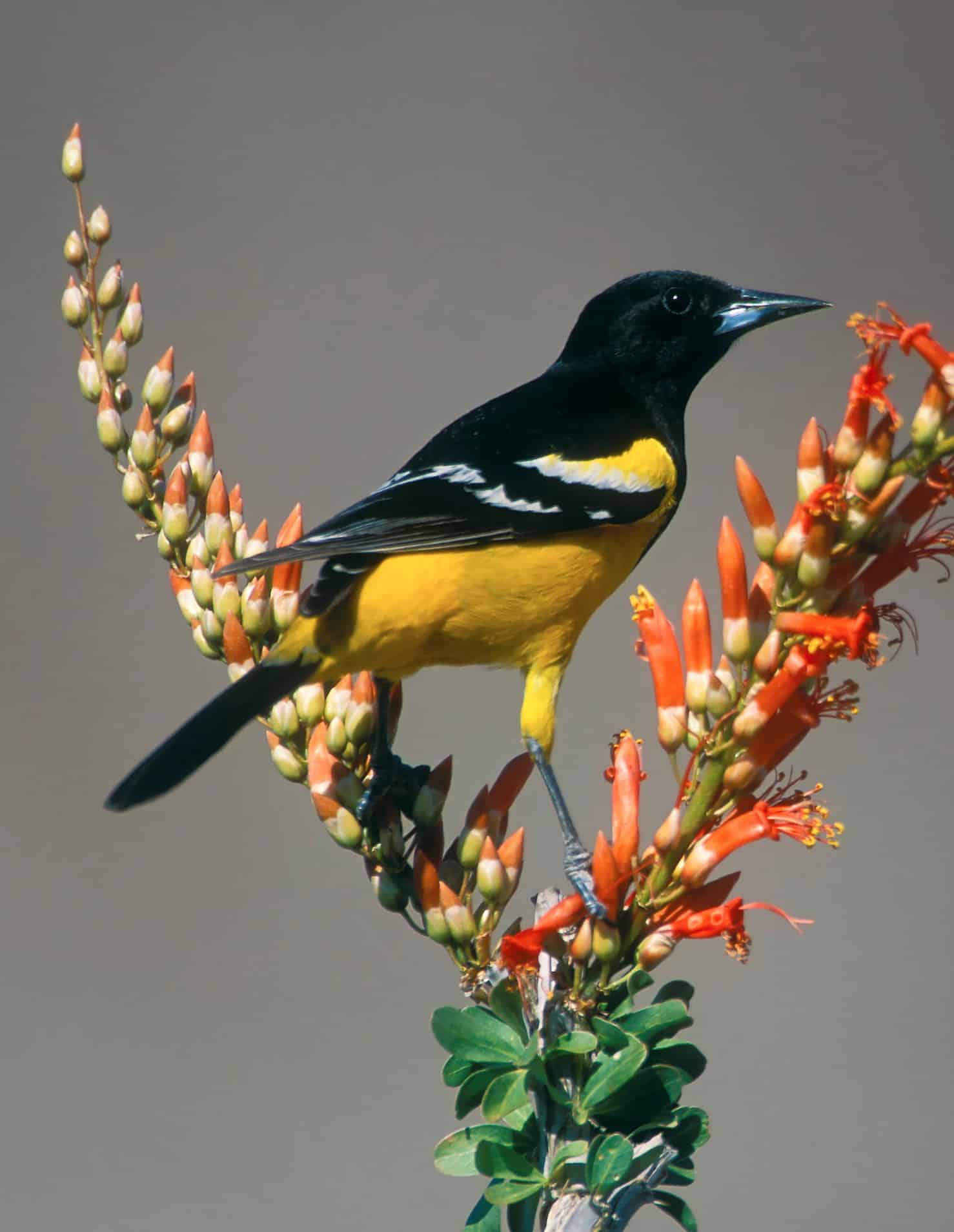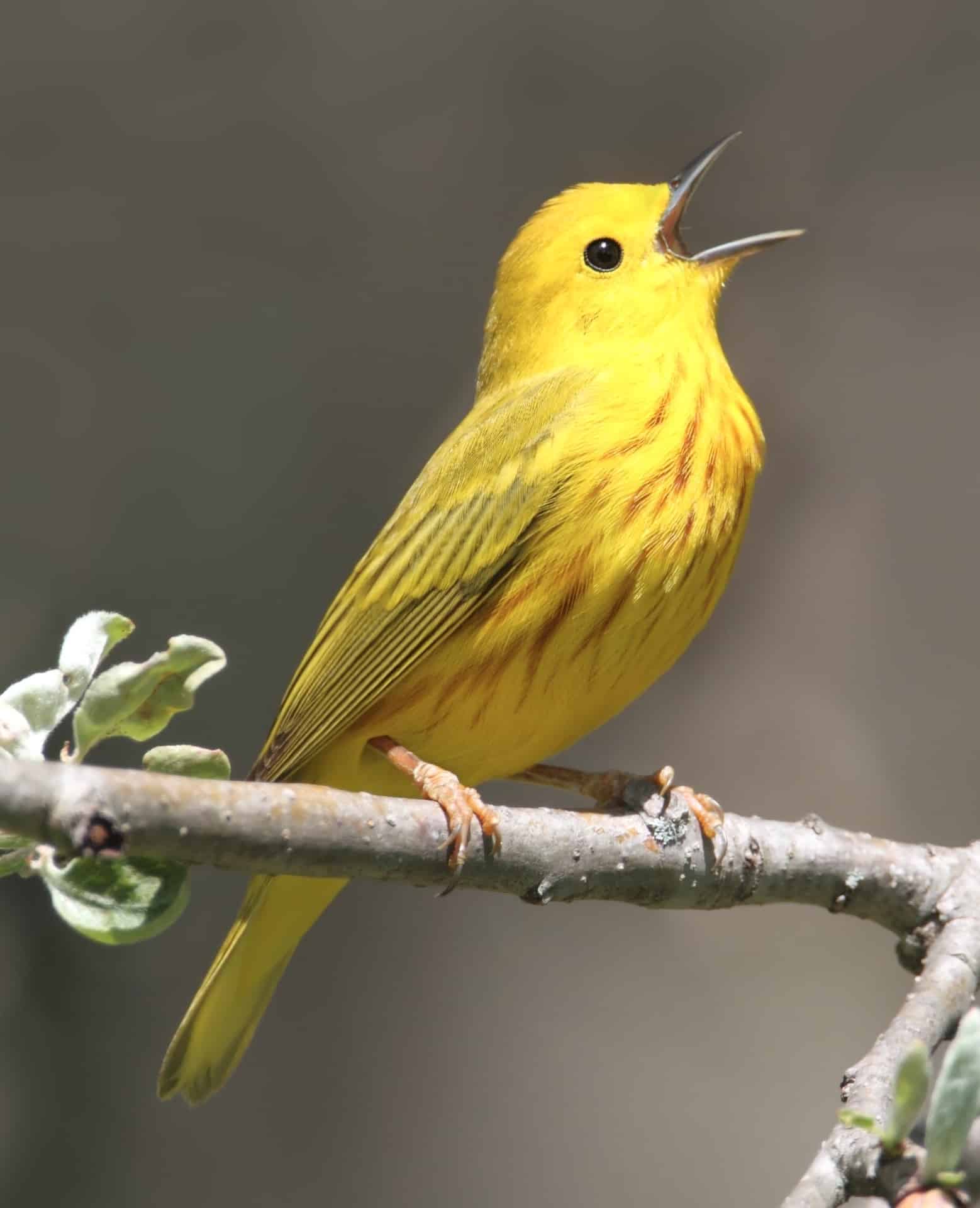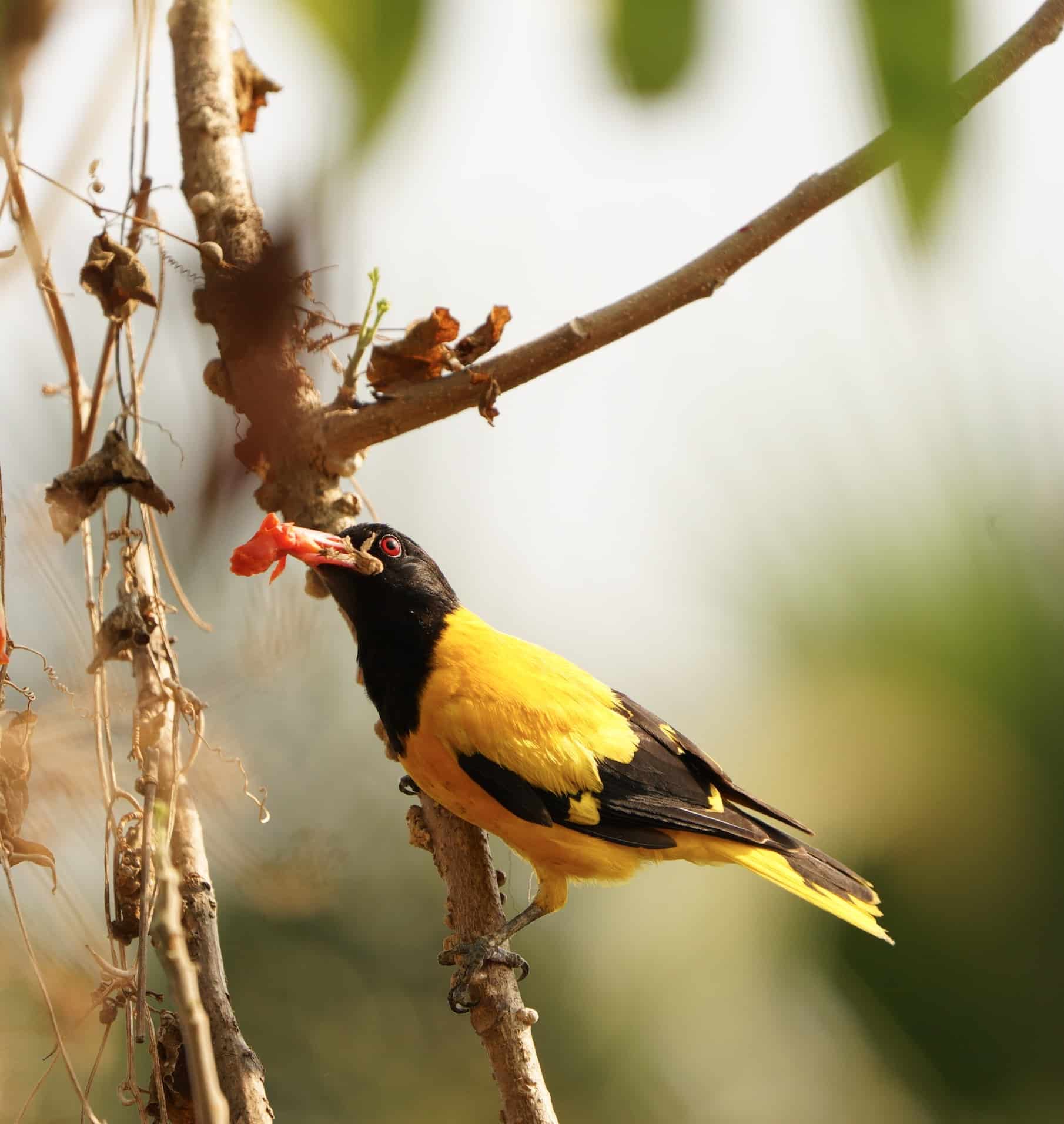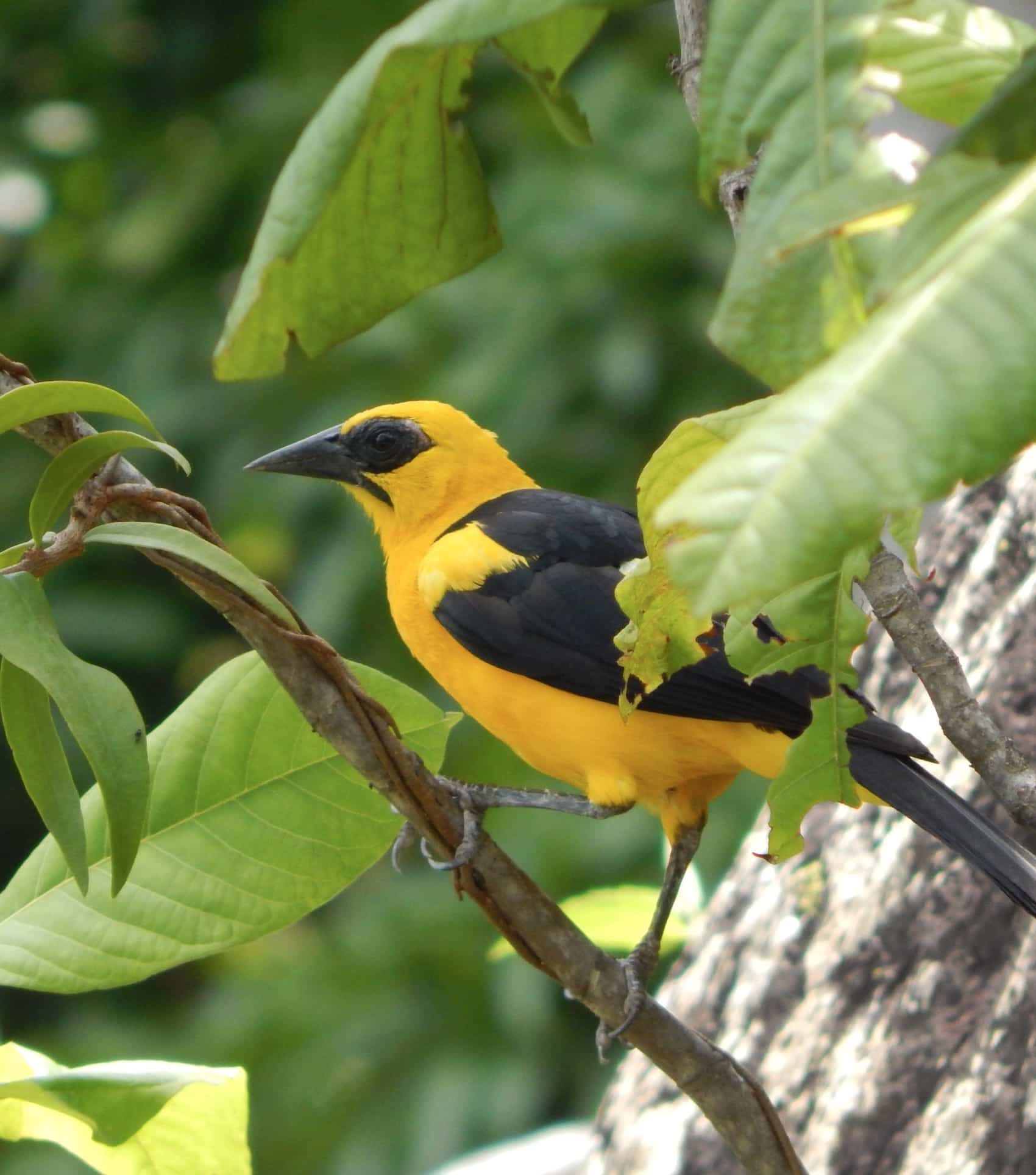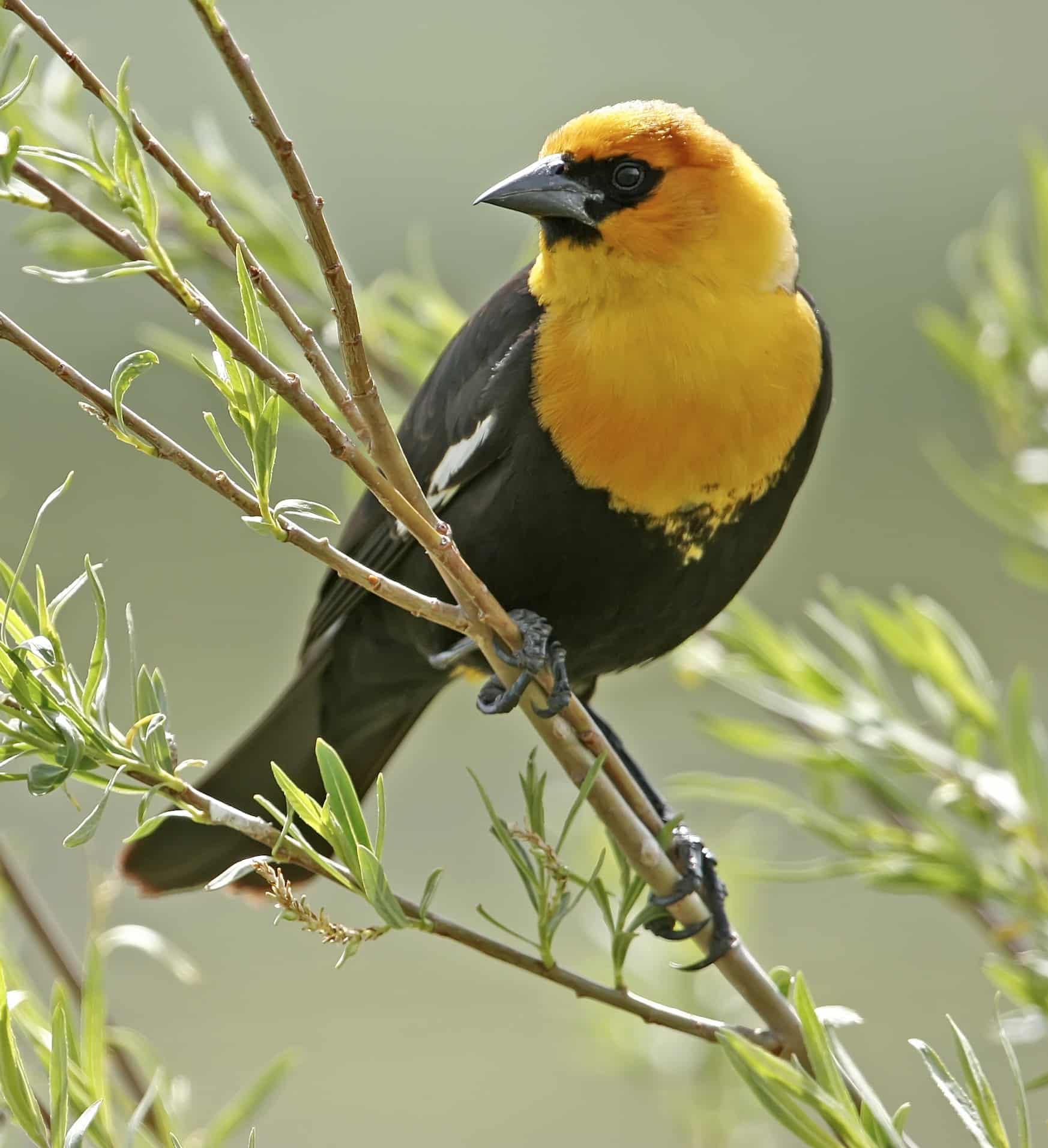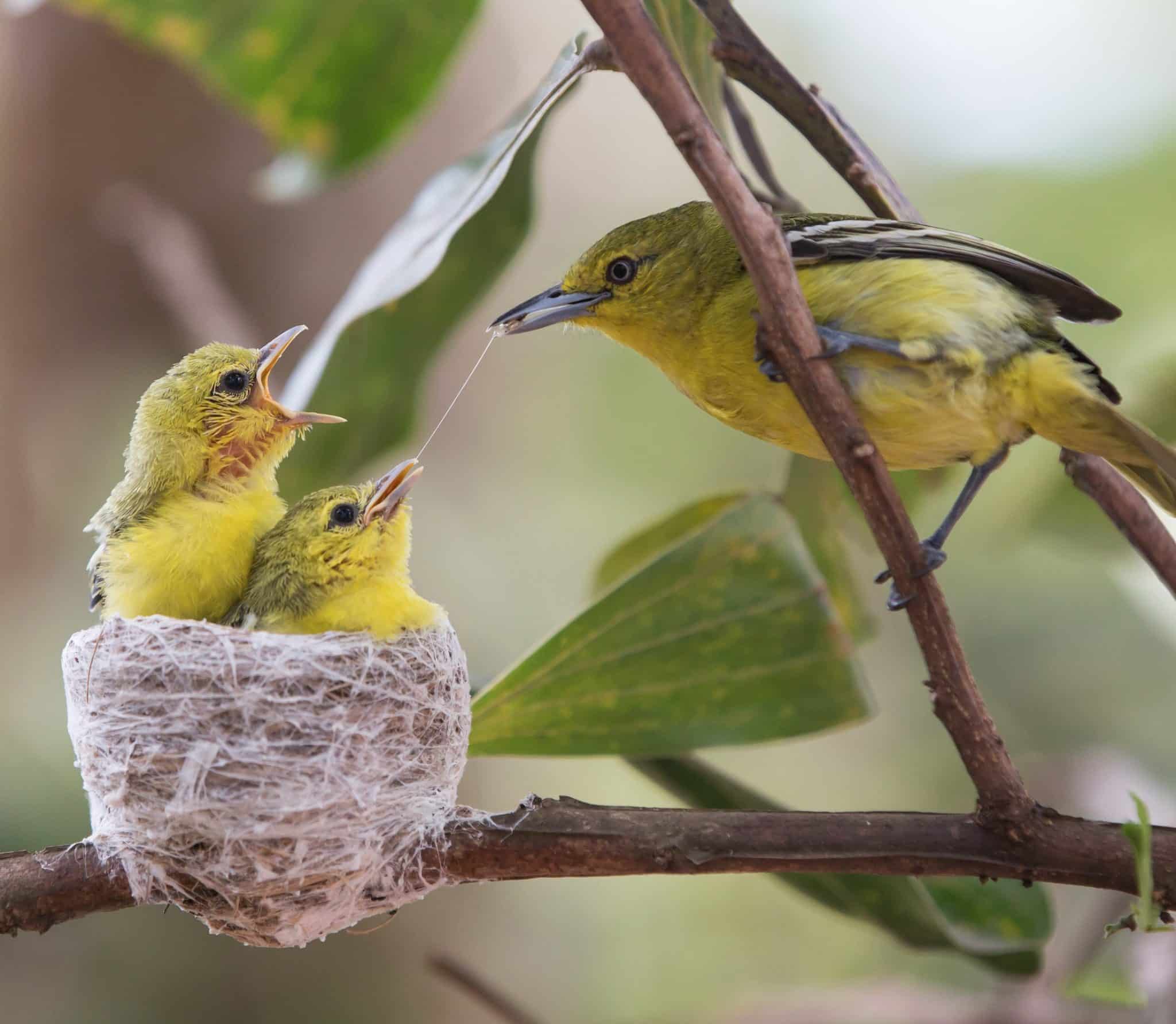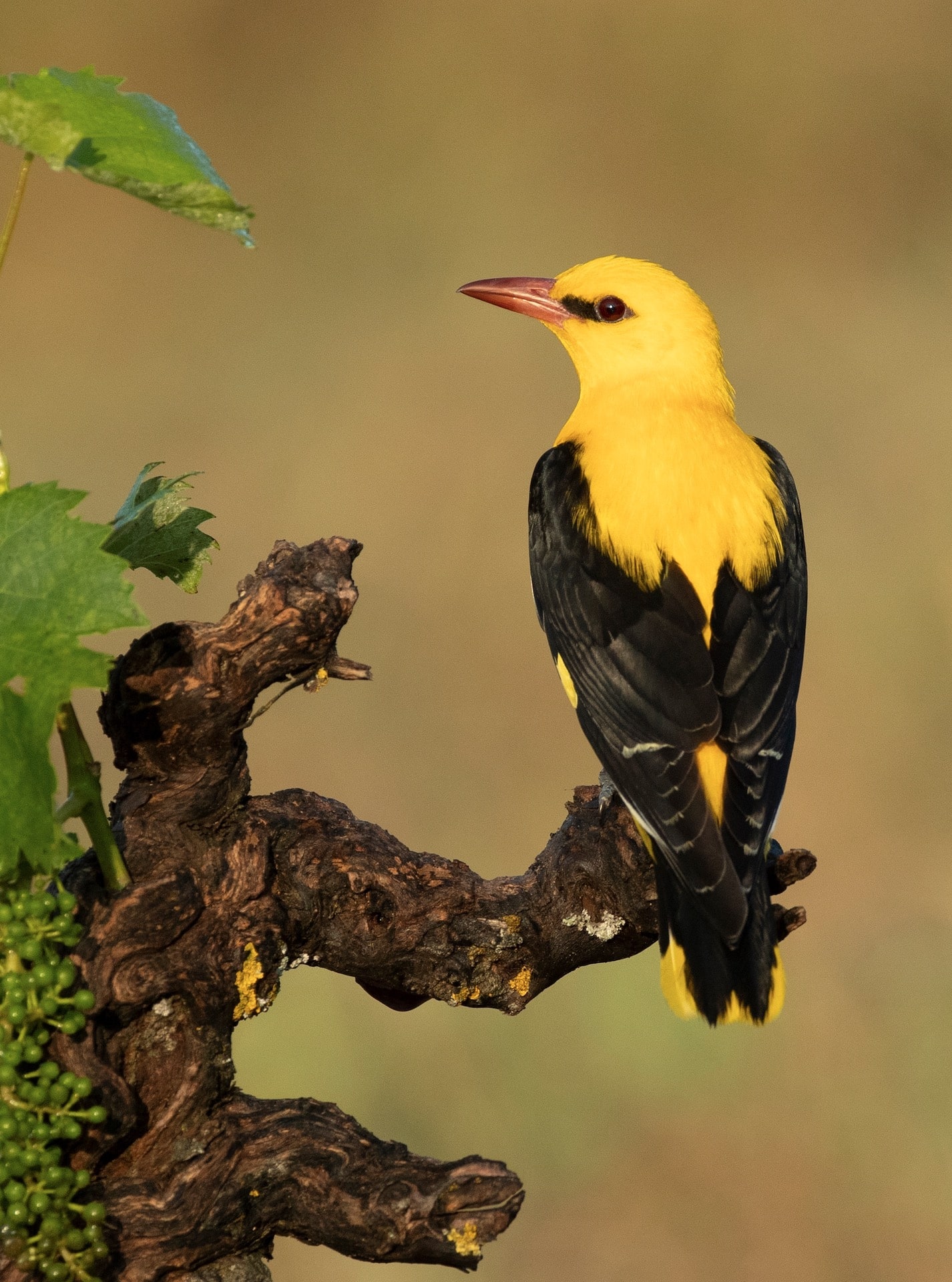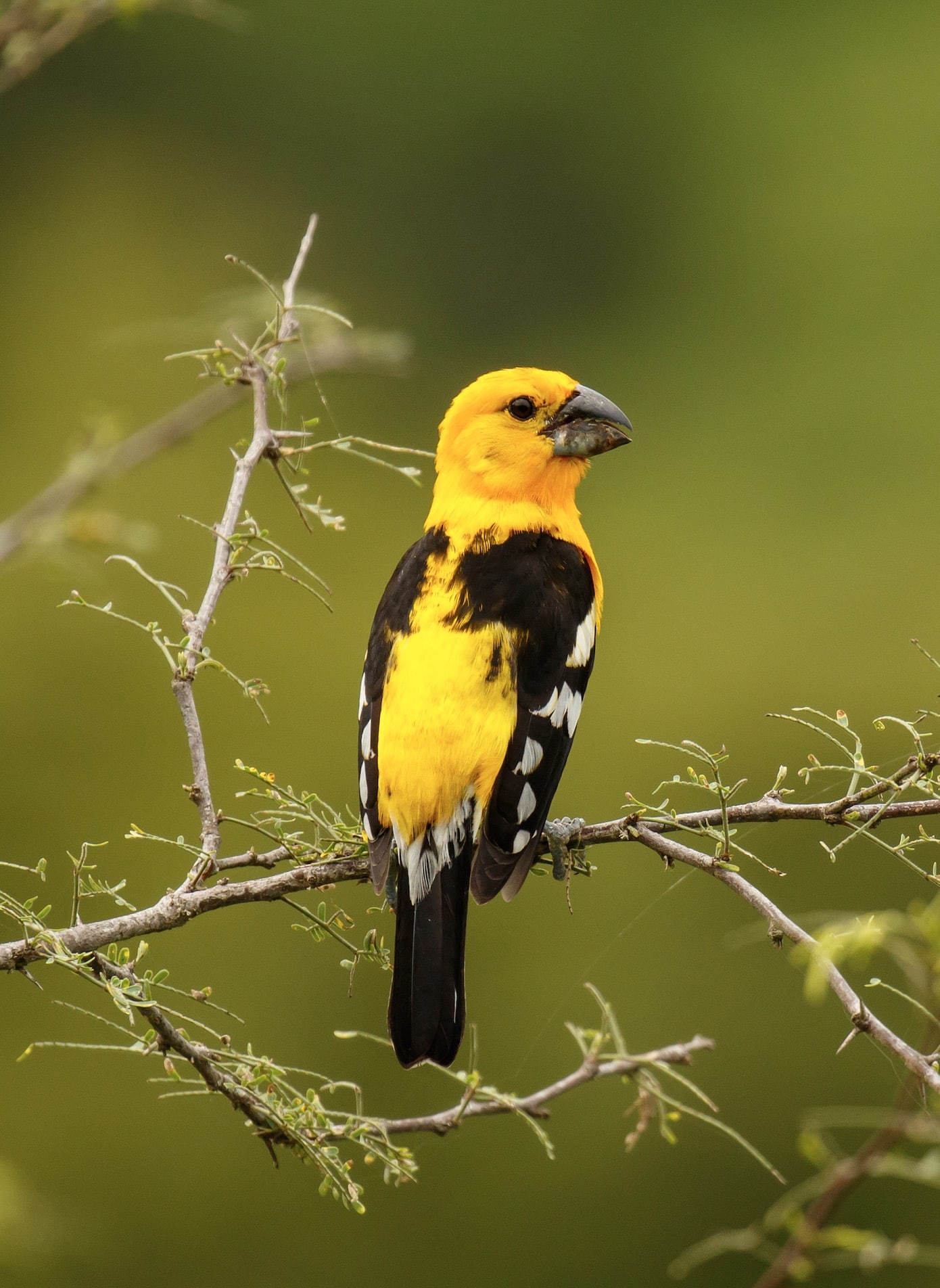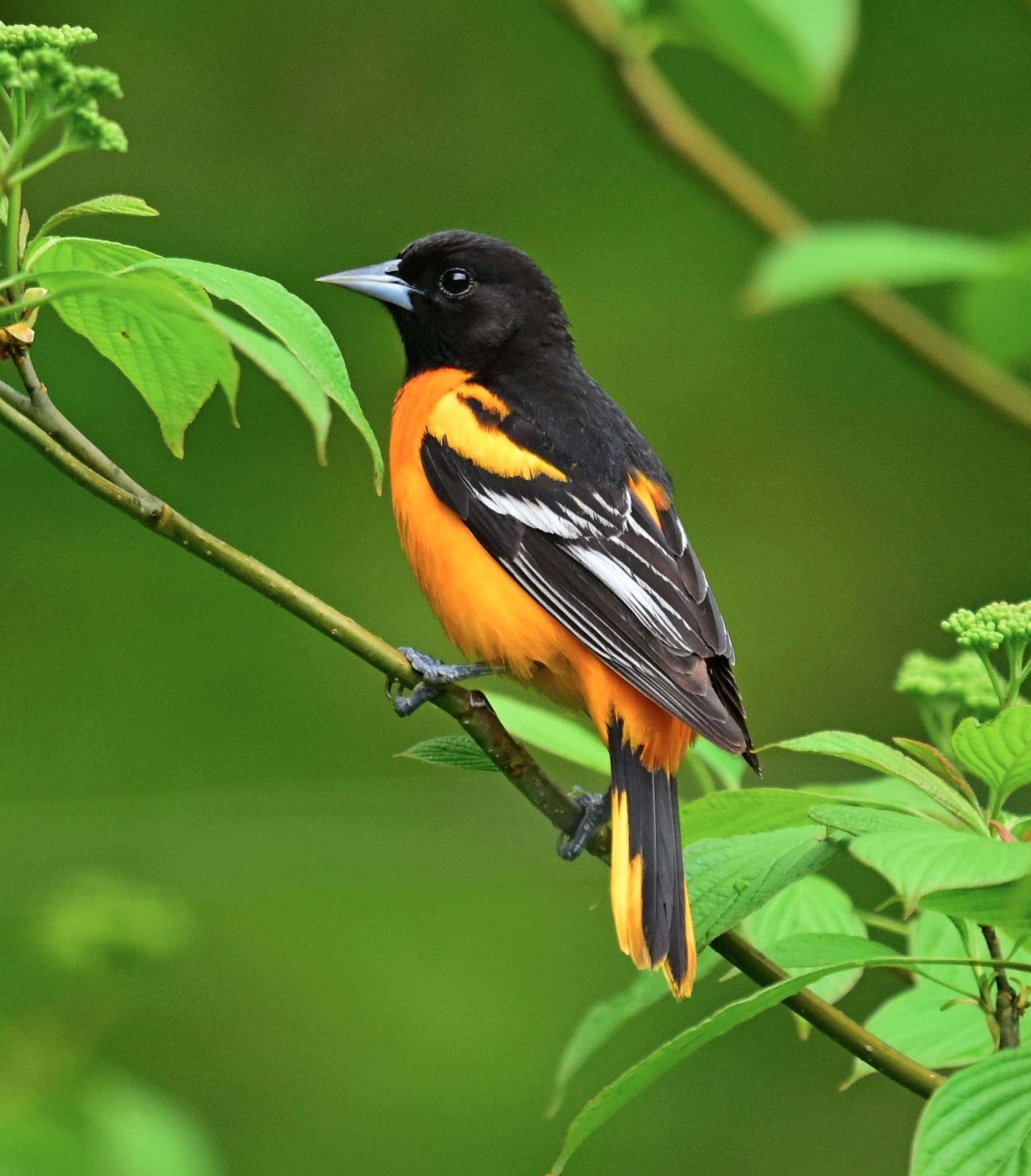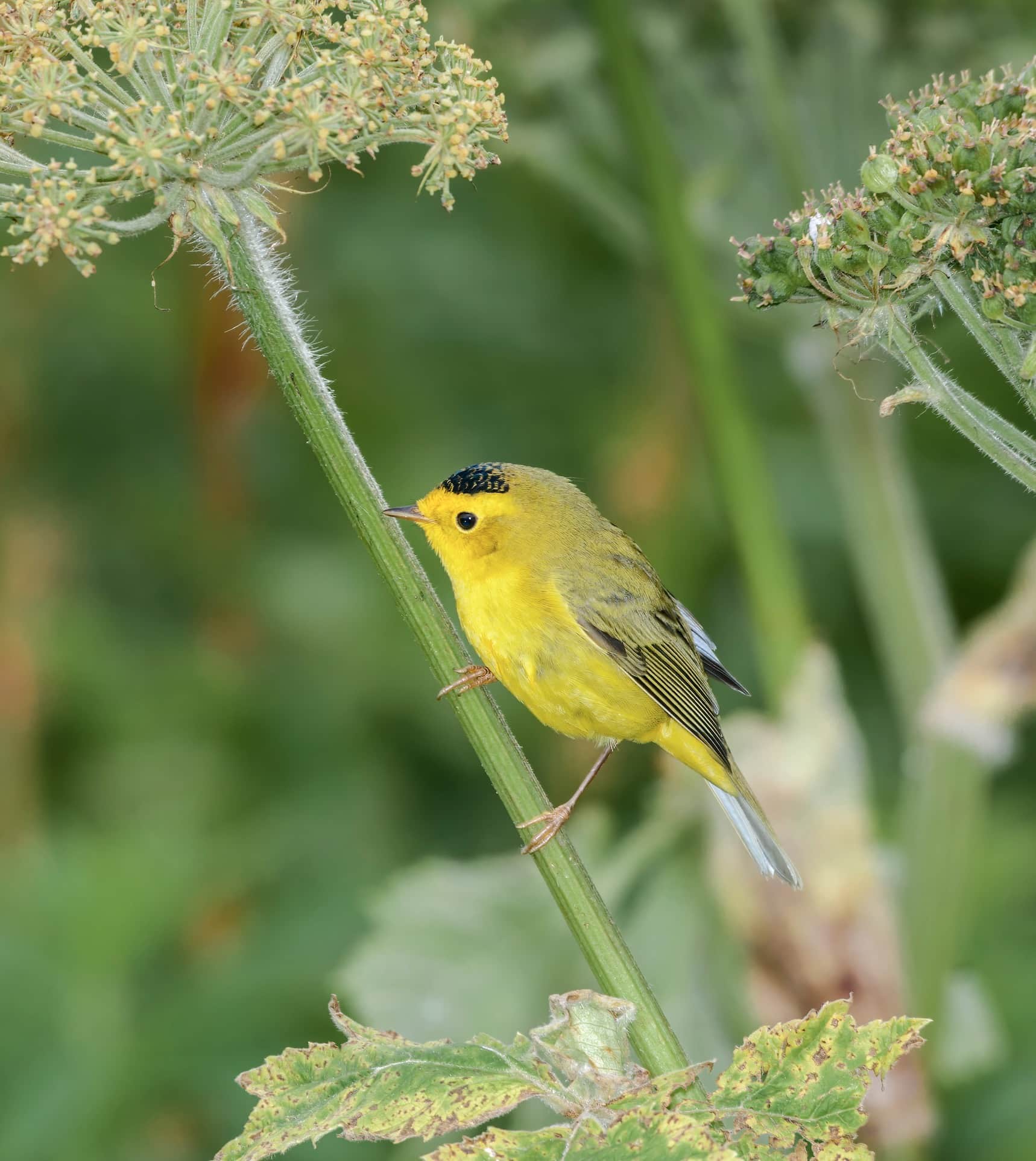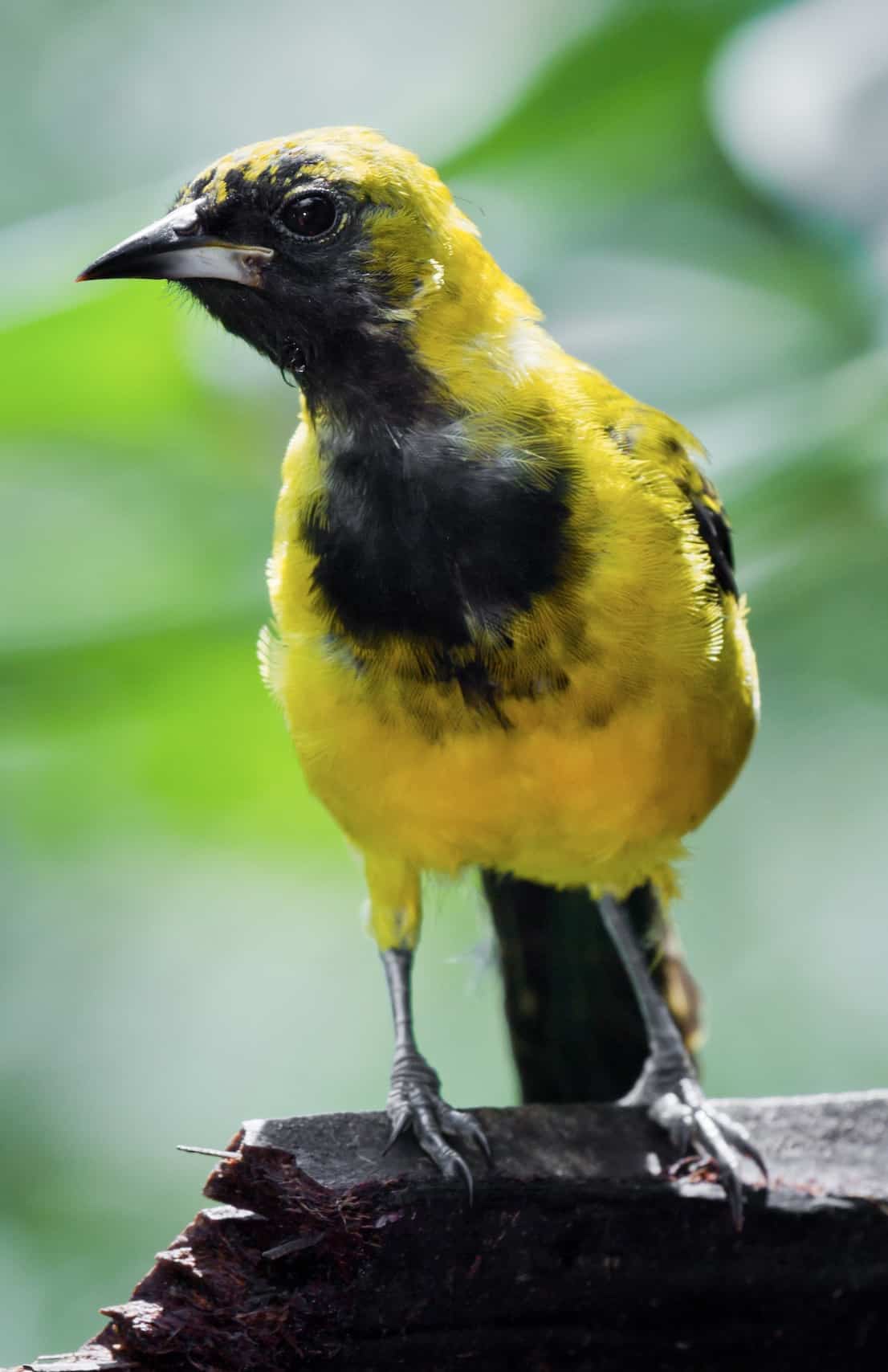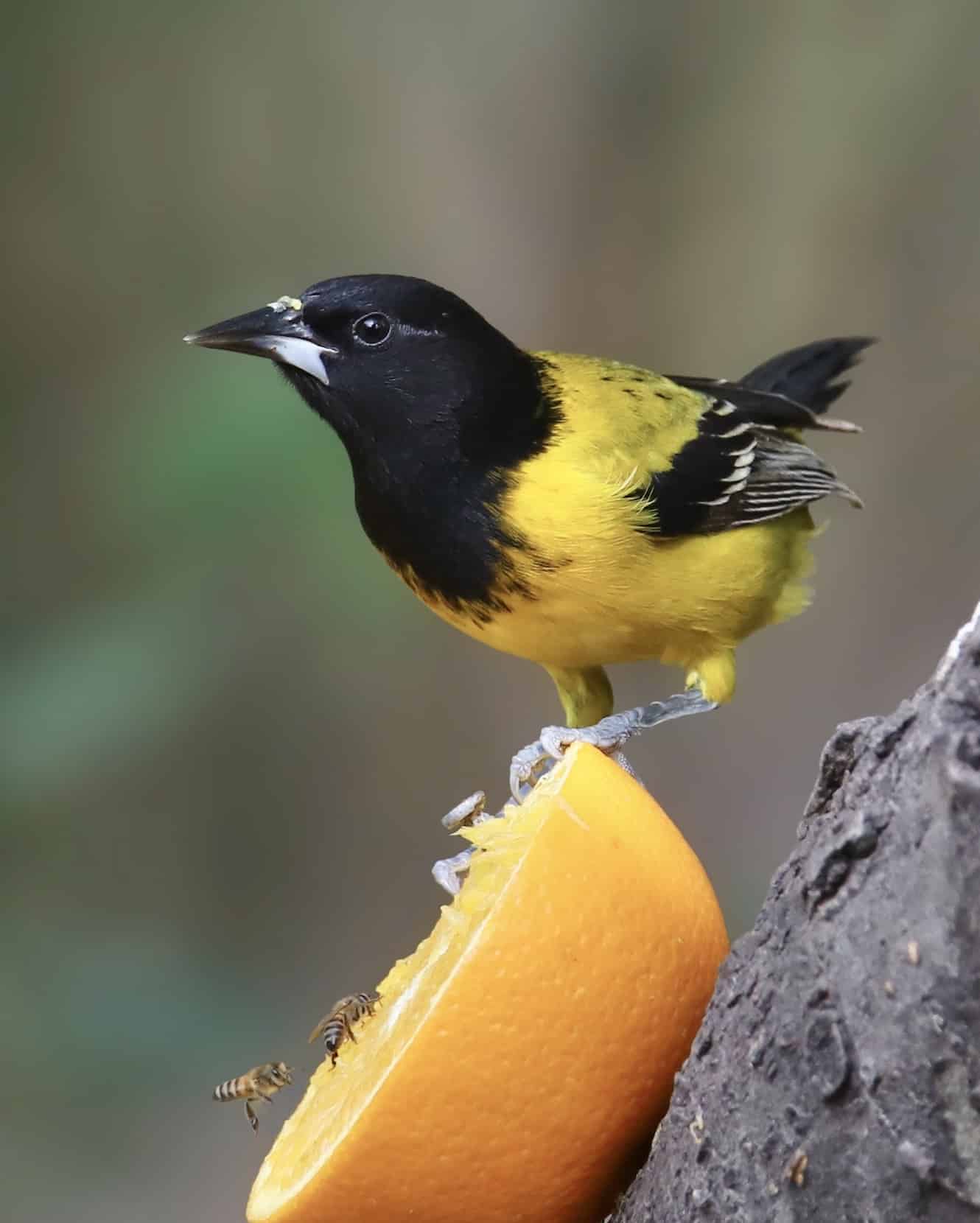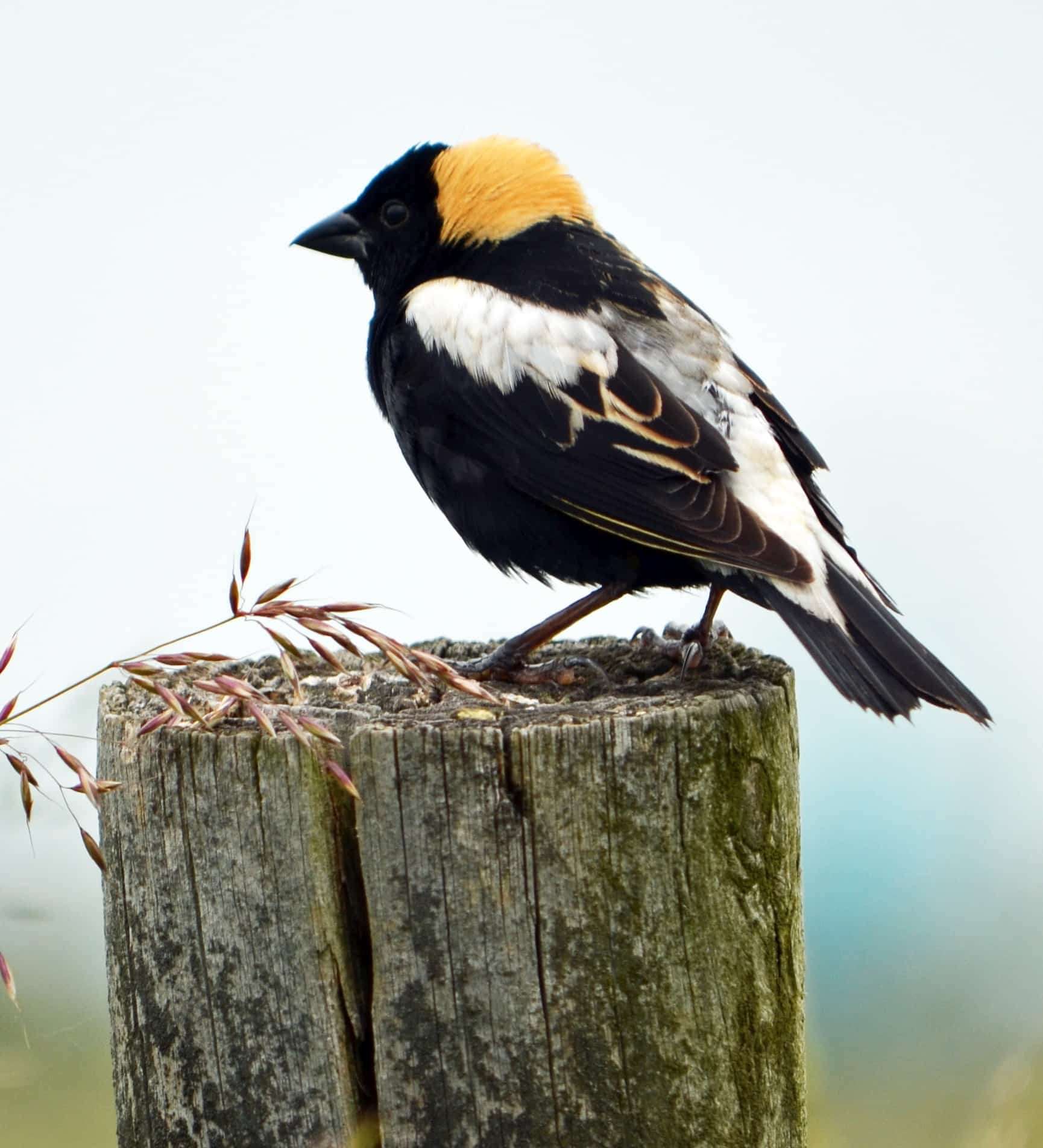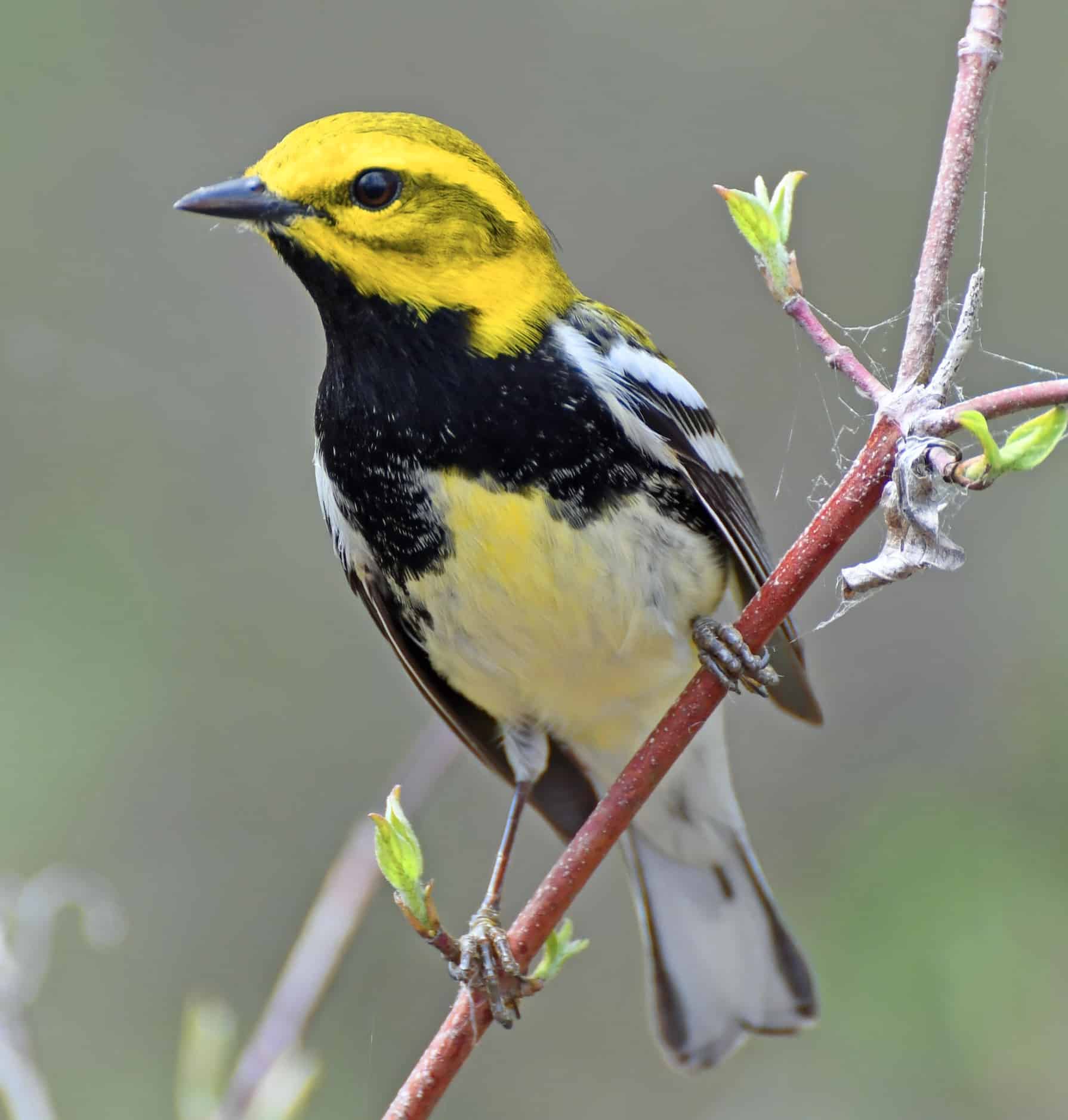Welcome to our guide to 17 yellow birds with black wings. Most of them live in the US or at least migrate here for part of the year.
1. American Goldfinch: Sunshine on Wings

Bird buffs, feast your optics on the American Goldfinch! Male goldfinches flaunt a bright yellow suit and chic black wings in the summer, turning olive in the off-season.
Females rock a year-round understated look with softer tones, but both genders sport those snazzy black wings.
Found flitting across the US and Canada, they head south when the chill sets in. Whether it’s at a feeder or in the wild, these seed lovers add a dash of sunshine to any day. Keep your eyes peeled—they’re pure eye candy for birdwatchers! 🌞🕊️
2. Evening Grosbeak: Bold Patterns in the Twilight
Meet the Evening Grosbeak, a chunky charmer with a flair for the dramatic.
The guys are donned in a golden-yellow body, accented by a striking black tail and wings—and let’s not ignore that massive white patch that screams ‘look at me!’
The gals? Classy in a more muted gray, with hints of yellow and those same dramatic black wings that just tie the whole ensemble together.
Though a bit of a misnomer (you won’t need to wait until evening to spot these beauties), Evening Grosbeaks are North American roamers.
They hang out from the dense forests of Canada to the mountainous regions of the western US, sometimes flying east in the winter. Want a closer look?
These bold birds might just drop by bird feeders when they’re on a break from their usual tree-top feasts. So, keep your binoculars at arm’s reach—they’re a spectacle not to be missed! 🌗🐦
3. Scott’s Oriole: Desert Warbler in High Contrast
Say howdy to Scott’s Oriole, the striking songster of the arid Southwest! Males rock a lemon-yellow body that could compete with the desert sun, set off by sleek inky-black wings and tail.
They’ve got a black bib and hood, too, like they’re suited up for a fancy shindig in the cactus-strewn landscapes.
Females take a subtler approach with their greenish-yellow attire and less pronounced black areas, but still look absolutely fabulous.
Scott’s Orioles are the serenading nomads of southern US states and Mexico, loving life in dry, open areas, especially where yuccas and agaves grow.
They are dab hands at weaving hanging nests which are a true craft project. If you’re trekking through their turf or just chilling out in the desert, listen for their melodious tunes. It’s like a mini-concert straight from nature’s stage! 🎶☀️🌵
4. Yellow Warbler: The Flitting Sunbeam
Prepare to be charmed by the Yellow Warbler, nature’s own drop of sunshine! These sprightly fellows wear a brilliant yellow from head to tail, with the dudes showing off some serious swagger with rusty streaks on their chest.
The ladies? They go for a more subtle, evenly light yellow across the board, but no less enchanting.
Calling the Yellow Warbler a homebody wouldn’t be fair—they’re real jet-setters. They summer in a broad swath across North America, from Alaska to Ohio, and take their vacation in Central and South America when it’s time to dodge the frost.
You’ll find them zipping around in willows and wetland margins, playing their cheerful tunes. Keep an ear out for their sweet “sweet-sweet-sweet, I’m so sweet”—it’s the anthem of the great outdoors! 🎵🌞🌿
5. Hooded Oriole: A Flash of Citrus in the Treetops
Ever seen a flying orange? That’s the Hooded Oriole for you! The gents are a dashing sight with their orange-yellow bodies and contrasting black throats and wings.
Sporting a sleek black mask, they’re the Zorro of the bird world. The ladies? They opt for a more demure yellow-green, but their elegance is undeniable.
These citrusy songbirds have a thing for the warmer climes. You’ll spot them from California and Texas down to Mexico, where they bring tropical vibes to palms and fruit trees.
They weave intricate hanging nests, showing off some serious craft skills. Whether sipping nectar or catching insects, they’re a burst of color and life, especially near human habitats. So, look up and listen for their whistling tunes—nature’s own merry melodies! 🍊🎶🌴
6. Oriole Blackbird: The Bold and the Beautiful
Get ready to meet the Oriole Blackbird, a bird that’s not your average backyard visitor!
These birds mean business with the males decked out in a striking jet-black body, but peep that gorgeous yellow epaulet screaming style on their shoulders and rump!
And the females? They’ve got the same cool look but softened up with a dusky brown-black and less vibrant yellow tones.
Chat about living the life, and Oriole Blackbirds will chirp in. They’re Latin American locals, hanging out anywhere from Panama to Ecuador, flirting with edges of forests and open grasslands alike.
They’re big on family, often nesting in colonies, and you’ll hear their gregarious chatter and see them strutting around like they own the place.
So if you’re trekking through Central or South America, keep an eye and an ear out for these social butterflies of the bird world! 🌿🎉🐦
7. Yellow-headed Blackbird: The Marshland Maestro
Prepare to be dazzled by the Yellow-headed Blackbird, the marshland’s own headline act. The males are impossible to miss with their startling bright yellow heads and chests, set against a suave midnight-black body. They’re like the tuxedo-clad stars of the bird world.
And the females? They keep it low-key with a more understated brownish-yellow head, blending smoothly with a darker body.
These striking singers are North American natives, favoring the freshwater marshes and wetlands, especially during breeding season.
Come fall, they pack their bags and fly off to the warmer southern states and Mexico for a well-deserved winter break. Their musical repertoire?
A mix of melodious tunes and grating chitchats. Find them perched on cattails or strutting in the reeds, ready for their next adventure!
8. Common Iora: The Feathered Acrobat
Get ready for a splash of color with the Common Iora, a tiny acrobat of the bird world.
The boys are all about that two-tone life, sporting lime-yellow underparts with a black cap, and not to forget those nifty black-and-white wings.
When they’re feeling frisky, they puff up and show off shocking bright yellow on their backs! The girls? They keep things chill with an overall olive-green vibe, but they’re just as charming.
This little winged dynamo is all about Asian locales, from India to Southeast Asia, loving life in open woodlands and gardens.
They’re social butterflies (or should we say birds?) and get mega chatty in mixed feeding flocks. Watch them flit and twirl through foliage like tiny, feathery Cirque du Soleil performers, often flipping upside down to snag a tasty insect meal.
If you’re adventuring in their neighborhood, look for their energetic displays—they’re nature’s own free-spirited showstoppers! 🤸♂️🍃🎨
9. Golden Oriole: The Elusive Golden Marvel
Behold the Golden Oriole, and you might think you’ve struck gold with wings! The gents are resplendent in a brilliant gold-yellow plumage that flows from their nape to their tail feathers, dramatically paired with jet-black wings that command attention.
And when they sing? It’s pure magic. The ladies prefer to fly under the radar with their greenish-yellow feathers, masterfully camouflaged among the leaves.
Eurasian adventurers, these birds grace the woodlands across Europe and Asia, from Spain all the way to Siberia!
When the temperature drops, they’re off for a tropical holiday in Africa, trading conifers for acacias. The Golden Oriole is a bit of a recluse, preferring to keep a low profile in dense treetops, but their sweet, flute-like tunes give away their hideouts.
Catching a glimpse of these golden treasures is a highlight for any birder—so keep your eyes peeled and your ears open! 🌳💛🎵
10. Yellow Grosbeak: The Brawny Balladeer
Get your binoculars focused for the Yellow Grosbeak, the bulky crooner with a color scheme that’s hard to miss.
Male grosbeaks are all about that eye-catching vivid yellow body, complemented by smart black stripes on their wings and a dashing black face mask. T
hey’ve got style and they know it. As for the females, they go for the softer look, with a more subdued yellow-olive hue and gentle wing markings.
Home is where the heart is, and for these guys, that means the Pacific slopes of Mexico, although some wander as far north as the southwestern United States.
They’re fans of open woodlands and forest edges where they can sing their sweet hearts out. If you’re lucky enough to spot one of these stunners at a feeder or foraging in the trees, you’re in for quite the serenade.
Spotting a Yellow Grosbeak is like finding a drop of golden sunshine in the tree—breathtaking and a little bit magical! ☀️🎶🌲
11. Baltimore Oriole: The Dapper Dandy
Step right up to witness the Baltimore Oriole, a feathered vision of orange and black.
The male oriole is a knockout with his brilliant orange underparts contrasted by his suave black head and back, not to mention those nifty black-and-white wings.
Females prefer a softer look with dull orange-yellow and a grayish back, a stylish subtlety that’s just as captivating.
These birds are the toast of the town across eastern and central North America, flaunting their stuff in open woodlands, along riverbanks, and in our own backyards.
Come winter, they swap snow for salsa, migrating to the warm tropics of Central America. They’re a crafty bunch, expertly weaving their sock-like nests from tree branches.
Catch their flute-like whistles and chirps as they flit from tree to tree, a true harbinger of spring! Orioles love sweet treats, so dangling an orange or a nectar feeder might just tempt these beauties for a visit. Spotting a Baltimore Oriole is like getting a front-row seat to Mother Nature’s own fashion show! 🧡🎵🌳
12. Wilson’s Warbler: The Perky Cap-Wearer
Let’s chat about Wilson’s Warbler, the energetic little sprite with a love for headwear.
The male is decked out in a neon-yellow plumage so bright, you’ll need shades, complete with a sporty black cap that says ‘I’m here to party.’
The females are trendsetters, too, donning a pale yellow and an olive cap—subtle, yet fashionable.
These pint-sized popstars are on tour across North America, serenading from Alaska down to the western U.S., before heading to warmer gigs in Central America during winter.
You’ll find them bouncing around in thickets and dense shrubbery, often near streams or wet areas. And they don’t just look cool, they sing like they’re headlining Coachella—only better because it’s nature, folks.
Spotting a Wilson’s Warbler is like catching a gleeful burst of fresh springtime joy! 🌟💛🌿
13. Yellow-tailed Oriole: The Tropical Tree Singer
Get tropical with the Yellow-tailed Oriole, a bird that brings the sunshine no matter where it perches.
The male struts his stuff in a golden-yellow body and tail that’ll make a mango jealous, paired with his distinguished black throat, wings, and back.
The females stay classy in a softer yellow tone and might skip the black throat, but they still fly the yellow-tail flag high and proud.
These feathered sunbeams love the warm vibes of Central America to the northern parts of South America.
They’re all about the lush life, hanging out in open woodlands, plantations, and sometimes even your backyard if you’re lucky.
Have you ever heard a trill so catchy it’s got its own rhythm? That’s the Yellow-tailed Oriole. They’re also quite the engineers, crafting long, hanging nests that swing in the tropical breeze like a hammock.
Spotting one is like receiving a sunny postcard marked with ‘Wish you were here!’ 🌞🎶🌴
14. Yellow-bellied Sapsucker: The Drilling Daredevil
Time to tap into the world of the Yellow-bellied Sapsucker, a bird that’s equal parts workaholic and artist. Males show off a slick white-and-black barred jacket and a red throat and cap, plus that tell-tale lemon-yellow belly that’s not just a clever name.
The females? They keep it cool with a similar pattern but swap out the red cap for a chic white one.
These guys are the percussionists of North American forests, from Canada to Appalachia, getting their groove on by drilling tidy rows of sap wells in trees.
Don’t be fooled by their name, though—they’re no slackers in the migration game, heading to the Caribbean and Central America when the jackets come on.
Their tree tapping not only nets them a sweet meal but also invites a buffet for other critters. Look for their distinctive drill work and listen for their mewing call—it’s like nature’s own Morse code. 🌳🔨🍯
15. Audubon’s Oriole: The Lone Star Singer
Y’all ready to meet a real Texan showpiece? Audubon’s Oriole is a stunner with a two-tone look that’s all about understatement.
The males go bold with a black hood and upperparts, beautifully contrasted by their yellow bodies and underparts.
And the females? They’re just as snazzy, sporting a similar color pattern but sometimes a smidge less vibrant.
This bird is a bit of a homebody, loyal to the brushy woodlands and mesquite thickets of South Texas and into Mexico.
They might play hard-to-get, often hiding out in the foliage, but their melodic whistles give away their hideout. Part of the intrigue with these orioles is their rarity; spotting one is like finding a hidden gem in the Lone Star state.
If you manage to see an Audubon’s Oriole, it’s like winning the birding lottery—time to do a happy dance! 💃🐦
16. Bobolink: The Meadow Maestro
Strap in for the Bobolink, a bird that’s all about the dramatic reveal! The male rocks a wild fashion reversal—it’s the only American bird with a white back and black underparts during breeding season.
Add a bold yellow cap, and he’s basically a pint-sized, feathered rock star. The females stick to a buff-brown streaked look that’s all about blending into their grassland stage.
These intrepid travelers are marathon migrants, jet-setting from North American prairies and meadows all the way to South America—a journey that racks up serious frequent-flyer miles.
When spring rolls around, their bubbly, jangly song fills the air, sounding like a R2-D2 with bird flu—in the best way possible.
Look for these globe-trotting troubadours bobbing in the grass or flying overhead in a bubbly, undulating flight. Spotting a Bobolink is the birding equivalent of catching a live concert—naturally unplugged and totally unforgettable! 🌾🎤🐦
17. Black-throated Green Warbler: The Forest Virtuoso
Alright, time to zoom in on the Black-throated Green Warbler, a dainty ball of feathers with a voice that could outshine an opera star.
The males sport an olive-green back with a zesty lemon-yellow face and a standout black throat giving them their name.
Plus, those streaky black side-lines on their white undersides? Pure elegance. The females and youngsters are just as lovely, with a slightly paler getup and often a dusky or smudged throat.
These little lyrical geniuses adore the high canopy, particularly of the eastern U.S.’s coniferous and mixed forests. But they’re not ones to shun a good vacation – they spend their winters in the balmy Caribbean and Central America.
Their tune is a perky “trees, trees, murmuring trees,”—so catchy, it’s practically viral in bird terms. To catch a glimpse of one, crane your neck upwards and listen for that sweet melody.
A sighting (or a listen) of a Black-throated Green Warbler is like hitting the eco-lottery jackpot! 🎶💚🌲
Condensed Identification Guide
| Name | Description | Location |
|---|---|---|
| American Goldfinch | Males: Bright yellow with black wings and cap. Females: Olive-yellow with darker wings. | North America. Migratory. |
| Evening Grosbeak | Males: Yellow with black wings, white markings. Females: Grayish-brown with white wing-bars. | North America. Migratory. |
| Scott’s Oriole | Males: Yellow with black back and wings. Females: Duller yellow with less black. | Southwestern U.S., Mexico. Migratory. |
| Yellow Warbler | Males: Bright yellow with rusty streaks. Females: Duller yellow, less streaked. | North America. Migratory. |
| Hooded Oriole | Males: Orange-yellow with black face and wings. Females: Duller yellow-green with less black. | Southwest U.S., Mexico. Migratory. |
| Oriole Blackbird | Bright yellow with black back, wings, and tail. | South America. |
| Yellow-headed Blackbird | Males: Yellow head and chest, black body and wings. Females: Brownish with streaks. | North America. Migratory. |
| Common Iora | Bright yellow with black wings and tail. | South and Southeast Asia. |
| Golden Oriole | Bright yellow with black wings and tail. | Europe, Asia. Migratory. |
| Yellow Grosbeak | Bright yellow with black wings and white patches. | Mexico, Central America. |
| Baltimore Oriole | Males: Orange-yellow with black head and wings. Females: Duller with less black. | North America. Migratory. |
| Wilson’s Warbler | Bright yellow with black cap; some black in wings. | North America. Migratory. |
| Yellow-tailed Oriole | Bright yellow with black back, wings, and tail. | South America. |
| Yellow-bellied Sapsucker | Males: Red throat and cap, yellow belly, black/white wings. Females: Duller with white throat. | North America. Migratory. |
| Audubon’s Oriole | Yellow with black head, back, and wings. | Mexico, Central America. |
| Bobolink | Males: Yellow nape, black body and wings. Females: Brownish with streaks. | North America. Migratory. |
| Black-throated Green Warbler | Olive-green upperparts, bright yellow face, with black streaks on back and wings. | North America. Migratory. |

